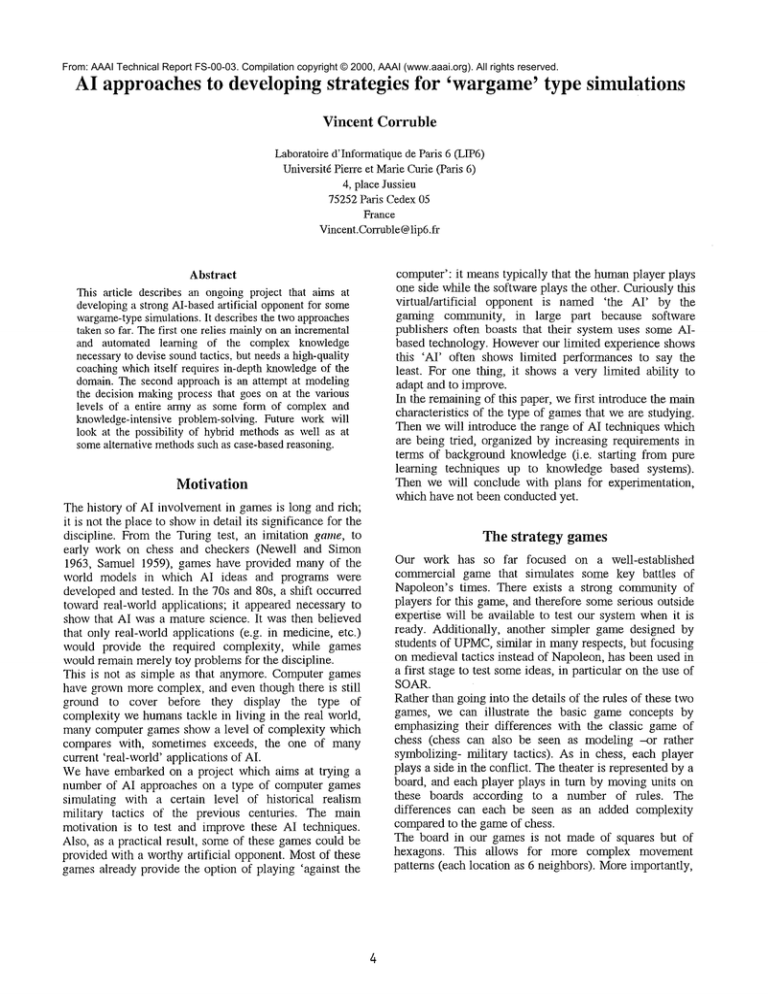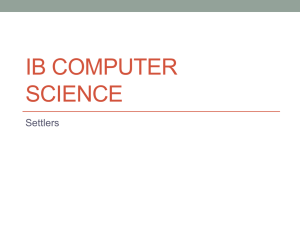
From: AAAI Technical Report FS-00-03. Compilation copyright © 2000, AAAI (www.aaai.org). All rights reserved.
AI approaches to developing strategies
for ’wargame’ type simulations
Vincent Corruble
Laboratoired’Informatiquede Paris 6 (LIP6)
UniversitdPierre et MarieCurie(Paris 6)
4, place Jussieu
75252Paris Cedex05
France
Vincent.Corruble@
lip6.fr
computer’: it meanstypically that the humanplayer plays
one side while the software plays the other. Curiously this
virtual/artificial
opponent is named ’the AI’ by the
gaming community, in large part because software
publishers often boasts that their system uses some AIbased technology. Howeverour limited experience shows
this ’AI’ often shows limited performances to say the
least. For one thing, it shows a very limited ability to
adapt and to improve.
In the remainingof this paper, we first introduce the main
characteristics of the type of gamesthat we are studying.
Then we will introduce the range of AI techniques which
are being tried, organized by increasing requirements in
terms of background knowledge(i.e. starting from pure
learning techniques up to knowledge based systems).
Then we will conclude with plans for experimentation,
which have not been conducted yet.
Abstract
This article describes an ongoingproject that aims at
developinga strong AI-basedartificial opponentfor some
wargame-type
simulations. It describes the twoapproaches
taken so far. Thefirst one relies mainlyon an incremental
and automated learning of the complex knowledge
necessaryto devise soundtactics, but needsa hi,a-quality
coachingwhichitself requires in-depth knowledgeof the
domain. The secondapproach is an attempt at modeling
the decision makingprocess that goes on at the various
levels of a entire army as someform of complexand
knowledge-intensiveproblem-solving. Future work will
look at the possibility of hybrid methodsas well as at
somealternative methodssuch as case-basedreasoning.
Motivation
The history of AI involvement in games is long and rich;
it is not the place to showin detail its significance for the
discipline. From the Turing test, an imitation game, to
early work o11 chess and checkers (Newell and Simon
1963, Samuel 1959), games have provided many of the
world models in which AI ideas and programs were
developedand tested. In the 70s and 80s, a shift occurred
toward real-world applications; it appeared necessary to
show that AI was a mature science. It was then believed
that only real-world applications (e.g. in medicine, etc.)
would provide the required complexity, while games
wouldremain merely toy problemsfor the discipline.
This is not as simple as that anymore. Computergames
have grown more complex, and even though there is still
ground to cover before they display the type of
complexity we humanstackle in living in the real world,
many computer games show a level of complexity which
compares with, sometimes exceeds, the one of many
current ’real-world’ applications of AI.
Wehave embarked on a project which aims at trying a
number of AI approaches on a type of computer games
simulating with a certain level of historical realism
military tactics of the previous centuries. The main
motivation is to test and improve these AI techniques.
Also, as a practical result, someof these gamescould be
provided with a worthy artificial opponent. Most of these
gamesalready provide the option of playing ’against the
The strategy games
Our work has so far focused on a well-established
commercial game that simulates some key battles of
Napoleon’s times. There exists a strong community of
players for this game, and therefore someserious outside
expertise will be available to test our system whenit is
ready. Additionally, another simpler game designed by
students of UPMC,similar in manyrespects, but focusing
on medieval tactics instead of Napoleon, has been used in
a first stage to test someideas, in particular on the use of
SOAR.
Rather than going into the details of the rules of these two
games, we can illustrate
the basic game concepts by
emphasizing their differences with the classic game of
chess (chess can also be seen as modeling --or rather
symbolizing- military tactics). As in chess, each player
plays a side in the conflict. The theater is represented by a
board, and each player plays in turn by moving units on
these boards according to a number of rules. The
differences can each be seen as an added complexity
comparedto the game of chess.
The board in our games is not made of squares but of
hexagons. This allows for more complex movement
patterns (each location as 6 neighbors). Moreimportantly,
4
while tile board contains only 64 squares in the game of
chess, it counts thousands of hexagons in the games we
consider here.
Each hexagon is defined, on top of its location, by a
numberof parameters, such as the type of terrain (forest,
plain, ...), the elevation, etc. whichin turn affect the units
ability to moveor fight.
Eachunit is defined by a numberof characteristics, which
affects its ability to move,to fight, as well as its quality,
fatigue, organization, etc. Someof them (such as the unit
configuration in line or column) can be seen as unit
parametersthat affect the unit’s abilities, such as moving
or fighting.
Units are organized ill a hierarchy (such as Army,Corps,
Division, Brigade...). The force cohesion requires that
units belongingto the same organization fight together.
Each game turn is divided in a number of phases which
are each devolved to a type of activity,
such as
movement,range fire, etc.
Combatitself is modeledin a relatively complexfashion.
It includes range fire (fire froma distance by infantry with
muskets or artillery) and melees (hand to hand combat).
Its resolution takes into account many parameters
including the size, quality, status, fatigue, etc. of each
side. It also includes a stochastic componentso that the
outcomeis (almost) never guaranteed.
A gameis wonby the side that scores the highest number
of points in a given amountof time (i.e. in so manygame
turns). Points are obtained by seizing (or successfully
defending) key locations, and by putting out of action
enemyunits.
Maybea more significant difference between our games
and the game of chess, from the computational point of
view, is that at each gameturn every one of the units can
be active. This departs radically from chess where each
turn sees each side choose a unique piece to move. The
resulting increase in complexity is very significant: If
there are p units in the games, each with m possible
actions, the resulting branching factor is p.m for chess,
while it is mp for our games’. Besides an explosive
complexity, this different setup has the advantage of
allowing a simulation that is muchcloser to history, or for
that matter to the simulation of humanagents, the theme
of this symposium. Armyunits do move in a parallel
fashion aroundthe theater so if historical plausibility is a
concern (and it is in our case), sequential action (as
chess) is out of question.
As a result, while blind search methods can be envisaged
to play chess to a certain level, this approach is just
inconceivable for our games, since even generating all the
possible states one turn forward is out of the question (for
m=20, p=100, 1.28.10 ’30 states would have to be
generated...). So even more than for chess, and as for
most ’real’ AI problems, everything rests in the quality of
the kalowledgeprovided to -or learned by- the system.
1 To makethings ’worse’, our gamestypically involve hundreds of units
on each side whileit is linfited to 16 in chess.
5
Active learning approaches
The first approach we have been experimenting with is
one that has the lowest requirements in terms of
back~oundknowledge. The idea is to start by simulating
small-scale confrontations and simple objectives so that
individual units can learn somebasic knowledge,and then
to learn incrementally
more complex knowledge by
simulating more complex situations. The first learning
method we are experimenting with is the genetic-based
learning of rule bases, and more specifically a method
inspired from Wilson’s work on ANIMAT
(Wilson, 1987,
Meyeret al., 1997).
Different setups are tried, someusing only basic sensory
information (besides the unit goals, information about
immediate surroundings, including the presence of enemy
units), and some representing in the genetic code some
intermediary concepts such as the perceived local force
ratio (directly implying the notion of threat). After these
initial stages, additional rule bases can be obtained by
having the units work in larger and larger formations, in
’coaching scenarios’ of increasing complexity.
This approachis very exciting since it is the most likely to
provide surprising results (because it is less biased by our
a priori on what would be an appropriate strategy for a
given situation). Surprise could be the result of someform
of strategic creativity shownby our systems. It could also
meanthat the rules of the game are unrealistic and that
our methodwas better than others (humanor artificial)
~.
finding the loopholesin these rules
This incremental approach to the learning of classifier
systems should improve our chance that the knowledge
bases eventually converge. Howeverit is too early at this
stage to conclude that they will actually converge. A
significant difficulty here lies in the design of appropriate
training scenarios of increasing complexity that can let
the system learn basic concepts and tactics and then more
advanced strateoes. It has appeared after our initial
experiments that this stage itself requires somein-depth
expertise on the game. Hence, though the learning method
seemed at first less demanding in terms of background
knowledge(and it is in manyrespects), it appears that
wouldbenefit greatly from all the lessons learned in the
phases of modeling and knowledge development of the
’knowledge-intensive’ approach.
Knowledgeintensive approach
At the other end, we are using a knowledge intensive
approach by eliciting the relevant knowledgewithin the
2 This wouldindeed connespondto a significant and well-known
occun-encein AI history, i.e. whenLenat’s Eurisko (Lenat, 1983) system
found a completely unrealistic but nonetheless extremely efficient
strategy for Traveler TCS,a simple simulationof naval battles. In turn,
finding loopholesin the rules of the gamecan be of a great interest.., to
the gamedesigners!
SOAR(Laird et al., 1991) framework. SOARhas proved
over the years to be a sound frameworkto represent and
use complex knowledge within a dynamic environment. It
has also more recently been successfully applied to a
number of computer games, after some application to
military simulation and planning. The difficulty here
resides in the formulation of good roles for the knowledge
bases, and to the choice of relevant intermediary
concepts. Also it is particularly important to makegood
use of the ability to learn by chunking within SOAR
since
our initial intuition was that current systems are
particularly limited by their inability to learn.
It wouldbe possible to see each unit as a different agent.
Indeed the game lets the player decide (within the
constraints of the current situation) the action of each unit
(infantry battalion, cavalry squadron for instance),
would the corresponding leader. However, the problem
solving activity of each unit leader makessense only in
the context of the global strategy devised by higherranking leaders (at the divisional, corps, and armylevels).
Hencethe information flow is bi-directional: on one hand
it goes upward (low-level leaders report on what they
observe, and on the success/failures of their actions) while
on the other hand information goes downward:strategies
are chosen, orders given, interpreted and as far as possible
implemented, sometimesafter some adaptation.
It was observed that this hierarchical information flow
bears an interesting resemblance with the way goals and
operators are organized in SOAR. Hence the design
choice has been so far to consider an entire army as a
single complex problem-solving agent whose hierarchical
structure is largely reflected in the SOARoperator
hierarchy. As a consequence of this choice, it has been
decided to share knowledge bases between units of the
same type, therefore not allowing ’individual unit
learning’ but only learning by unit type. Of course each
level in the hierarchy of the unit organization does its
learning independently from lower or higher levels.
Also the game has a special coaching mode where the
user has the ability to suggest a course of actions to the
program when its current knowledge base is either too
poor or inadequate.
Future
work
Anotherapproach that we wish to investigate is the use of
someforms of lazy learning for our games. This approach
would place itself in between the two previous ones in
terms of requirements in a priori knowledge. Case-based
reasoning does need some knowledge in the choices
relative to the representation of the cases, the organization
of the case base, the similarity measure used for case
retrieval, and the strategies for adaptation. Therefore the
requirements are higher than for the genetic-based
learning approach, but lower than for the knowledge
intensive approach. This approach will have the
advantageof proposing as solutions to potential situations
entire plans of actions that will have succeeded in the
6
past. Again, different case bases will be required for the
different levels of the organization. An important element
to take into account in the calculation of the similarity
between cases is the similarity between the units"
objectives
since similarity
between situations
(geographical and surroundings) is not enough to motivate
the retrieval of a case.
Besides trying more techniques, future work will require
combiningthe most promising ones in hybrid systems that
can rely on the technique the most adapted to the current
situation. Since all the techniques seen here rely on some
element of learning, it is necessary_ to allow someform of
experimentation where the system can play against itself
at high speed to reach some basic performance level. For
the active learning approach, the methodwill be greatly
enhanced by having the system play against the
knowledge intensive method (even if its knowledge base
is simplistic at first). The idea here is that the active
learning method will start as a ’random" player (before
anything is learned) and would therefore not show much
progress by playing against itself. Additionally, the
knowledge acquired with the knowledge-intensive
approach will be helpful to design better coaching
scenarios for the incremental active learning approach.
Experimental results on the two first approaches
introduced in this paper are expected by the time of the
symposium.
Acknowledgements
A numberof CS students of the University Pierre et Marie
Curie played active parts in the initial stages of this
project. I wish to thank Louis Montagne and Pierre
Falticska (from the ’DESSIA" graduate program) as well
as the following undergraduate students: Gilles B6nichou,
Josg De Sousa, Fabien Flacher, and Fabrice Serri6re.
References
Laird, J.E., Newell, A., Rosenbloom,P.S. 1991. Soar: An
Architecture for General Intelligence.
Artificial
Intelligence, 47:289-325
Lenat, D. B. Eurisko: A program which learns new
heuristics and domainconcepts. Artificial Intelligence,
21, 1983.
Meyer, C., J.-G. Ganascia, and J.-D. Zucker. (1997).
Learning Strategies
in Games by Anticipation.
International Joint Conference on Artificial Intelligence
(IJCAI), Nagoya, Japan
Newell, A., & Simon, H.A. (1965). An example of human
chess play in the light of chess playing programs. In N.
Wienerand J.P. Schade(Eds.), Progress in biocybernetics
(Vol. 2, pp. 19-75). Amsterdam:Elsevier.
Samuel, A. Somestudies in machine learning using the
game of checkers.
IBM Journal of Research and
Development, 3(3):211--229, 1959
Wilson, S.W. 1987. Classifier Systems and The Animat
Problem. MachineLearning, 2 (3), 199-228.



